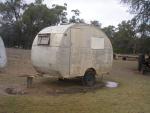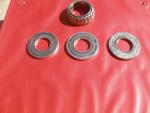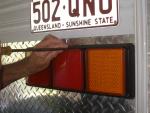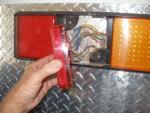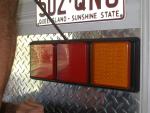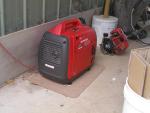
Grahame and Wendy Roberts
Ordinary Member-
Posts
50 -
Joined
-
Last visited
-
Days Won
2
Content Type
Profiles
Forums
Events
Documents
Store
Everything posted by Grahame and Wendy Roberts
-
Rick, I have never carried a ladder and have as noted by another KOGGER borrowed from the maintenance manager at caravan parks etc and have never been refused. However lately I have cleaned our four solar panels by parking the L,Cruiser close to the caravan and stepping via the spare wheel onto the roof of the vehicle. By staying on the curve of the roof which offers rigidity easy access can be gained to half the caravan length. Regards, Grahame
-
The New Kedron!
Grahame and Wendy Roberts replied to Grahame and Wendy Roberts's topic in Public Forum
Sorry folks, The whole idea of this post falls flat if you dont have the picture. After adjusting my settings I have had another go at attaching the photo of the New Kedron. I hope it works this time. Apologies from Grahame -
The New Kedron. Thought you might like to take a peek at the new Kedron unit about to wow the market in 12/13. Minimilist baby styling - a fit in with just about anything paintjob - heavy duty tyres to handle the rough going - electrics, yes there is a 12V bulb inside and a stop lamp at the rear but all that other fancy wiring just causes trouble - dont you love that forward facing window and yes a top hatch to let the bugs in and it comes complete with a sail track the full length of the van. You can see how well it handles the wet standing high and dry with a puddle to the fore and aft.
-
Eyre Peninsular in the New Year
Grahame and Wendy Roberts replied to RussnSue's topic in Public Forum
RussnSue, Eyre Peninsula and the wind go together of course. Places we remember are a great spot up on the sand dunes overlooking a small bay 200M past Tractor Beach (608 Camps 5). A magnificent view on a bare rocky headland 150M above the sea at Sheringa Beach (590 Camps 5) on LH side about 700 or 800M past the designated camp place, walk before you park here as these headlands are pocketed with caverns underneath. Port Gibbon ( 560 Camps 5) has many spots where you are right on the water and on your own, some dirt but bitumen not far away. There is a car ferry between Wallaroo (Yorke Pen) and Cowell if you don't want to take the long road around through Port Augusta. If you go to Pt Augusta then south towards Adelaide, the road through Horrock's Pass, steep pull up the pass, to Melrose and back onto the main road through Murray Town, windy road follows old bullock track, to Port Germein is a pretty run. There is a good camp at the showgrounds north of Melrose (357 Camps 5. Grahame & Wendy -
Removing tail light assembly
Grahame and Wendy Roberts replied to Ian and Sue's topic in Public Forum
Red Ruby, How to remove LED tail light assembly is all there, including picks, on the Forum. See "Dont take Your LED Stop/Tail lamps for Granted" started by Grahame & Wendy Roberts. Regards, Grahame -
Chris, Good morning. Not enough info here for any real diagnosis at a distance. Most solar regulators have a "low battery" disconnect feature which switches off the load terminal to protect against deep discharge and which re-connects when the voltage rises above a preset threshold. You say batteries were checked - how were they checked. When looking for problems of this nature think through what has changed, what has been worked on. It sounds like a loose battery cable connection would be a good place to start. Regards, Grahame
-
Axle Washer Tearing
Grahame and Wendy Roberts replied to Grahame and Wendy Roberts's topic in Public Forum
Tony and John, Thanks for your comment on your techniques on handling pre-loading of the bearing set. I rang Vehicle Components this morning and talked to a Senior Salesman, Paul, who has been with them some time. He had seen some wear on washers coming in on gear being brought to the sales counter by customers. His recommendation for 12 in hub sets on heavy caravans is to tighten to a "firm" setting then back off close to one flat. He says they do not make or sell a hardened washer and that the usual standard soft mild steel washer is supplied on all their hubs. He did say that re-greasing every 10,000k is most important. So that is the point of view from VC - all grist for the mill. Thanks again for your interest, we may see you on the road. Regards, Grahame -
Axle Washer Tearing - Suggestions Please I have been working in the wheel bearing and brakes department on our Kedron lately. Over some time I have noticed that the wheel washers holding the hub on the axle show signs of tearing on their inner or bearing surface. The tearing I believe leads contamination of the grease with small metal particles which quickly wrecks the outer bearing. I have just replaced two outer bearings which were showing marks on the bearing surfaces after only 5,500ks. When towing I am always conscious of not attempting tight turns which puts colossal side thrust on wheel bearings and would "mark up" the soft washer surface. On nut tightness I have always done them up moderately tight, then backed off, half to one flat to get the split pin in. Does anyone have comment on how to manage this issue please, perhaps surface hardened washers?. Thanks, Grahame
-
John, Some pics on how to remove LED lamp sets. The Sikaflex used when fitting the lamp sets, and mentioned in this thread, does "glue" the lamp into position which can mean a fair bit of force is required to prise the lamp off the back of the van. There is a real risk of chipping the surround. My recomendation is dont take this on unless you have to - when your lamp is blown you have to. The procedure is in essence to unlock ramped tabs which hold the lamp in the surround. The only thing I have not shown here is the use of a second screwdriver to help prise the lamp out of the surround - required when the Sikaflex has a hold of it.
-
Thanks for your comments people. John, I know what you mean - leavering away with a big screwdriver could lead to some expensive replacements. I did have photos of this whole operation, and each failed LED lamp, but have misplaced them on the computer. Over the next couple of days I will take a couple of pics and post a methodology. Grahame
-
An LED Stop/Tail, Indicator Story When I saw light truck LED lamps being installed on our Kedron I was very pleased - well, I thought, there's something I will not have to concern myself with for the life of the van. Not so folks - don't take them for granted. We recently took the caravan out of our big shed a few days before leaving on a major trip, it makes for easier packing. As we have plenty of space we generally spend at least one night installed in the van to check nothing has been missed and all systems are operating. Over three days there were rain showers off and on but nothing heavy. On a passing whim I decided to check the operation of the rear lights. To my astonishment no right indicator (orange), one totally failed stop/tail, and a partially failed stop/tail, about half the 64 LEDs were operational. I removed the failed lamps from the plastic surround. One needs a flat bladed screwdriver to lever the surround away from the lamp and move the lamp outwards, it will then hang on its wires. On close examination I could see fine water droplets inside the lamps and discoloration of the printed circuit boards that carry the LEDs themselves. The construction of these lamps is very high quality - close to a military spec - a moulded outer polycarbonate casing, carrying the PC board with the back sealed with a resin filler, which seals the wire exits. I decided to do some testing of my own. I left the lamps in the sun for an hour then submerged them in a bucket of water. Sure enough water droplets could be seen inside. One lamp had half a teaspoon of water sloshing around in it. Then I left them in the sun again - all sign of water droplets disappeared. On repeating the experiment the same thing happened Eventually I was able to detect very fine cracks in the corners of the moulded casing. The manufacturer is LED Technologies Pty Ltd who have a comprehensive site at ledautolamps.com. They manufacture to ISO 9001 standards and claim to use resins and glues which do not crack. The lamps carry a manufacturer's warranty of five years, (van is three years old). I contacted them and was told to return the lamps and if they agreed the product was faulty they would post a replacement. Not the answer one wants to hear on the eve of leaving. Ashley at the Kedron factory was good enough to replace the faulty lamps and I wired them in and we left on time. I have since learnt that Bustracker do not use LED stop/tail, indicator lamps. They have stuck to the less expensive but tried and true standards. Any comments? Grahame
-
Hubs, bearings and studs.
Grahame and Wendy Roberts replied to Pete and Tracey's topic in Public Forum
Pete and Tracey, I have not suffered a spinning stud myself but have seen the results, not on Dexter drums though. I have cut through the stud with a hand held grinder. The stud has a coarse spline which is pressed into the cast iron brake drum. Vehicle Components may sell an oversize stud, however if the stud has been flogging around it could have broken out material around the stud hole and that probably means a new drum. I am not sure how far you are from northern Brisbane. The suspension and brake assemblies Kedron have used for some time are manufactured by Vehicle Components at 352B Bilsen Rd, Geebung Brisbane. Ph 3624 3800. They have a good PDF catalogue on line. Their site is vehiclecomponents.com.au There is no way you will remove the grease seal from the back of the hub without damaging it. If you are on the Gunbarrell Hwy, 400k from help, by all means tap it back in to get to town, but they are cheap as chips. Either press the larger bearing assembly out with an hydraulic press if you have access to one or using a solid surface tap it out with a long round punch working side to side through the axle hole. If you have removed a bearing set I would replace it with an all new set. Wheel bearings on the 12in Dexter drums are Inner LM 501310 & LM 501349, outer L 68149 & L 68110, seal 10 X 76 X 46 mm. I have found that even in large towns this set has to be brought in by bearings traders so I carry two sets of bearings and seals, enough to redo one side of the caravan. Interestingly my experience over four years is that the roadside set of wheel bearings suffer more damage from water ingress than the ones running in the centre of the road. I have put it down to splashing through more water at the side of the road. Grahame -
Battery and charging Q's
Grahame and Wendy Roberts replied to Pete and Tracey's topic in Public Forum
Kev, Get a new set of batteries, and make sure your solar controller is set up correctly. Grahame -
Battery and charging Q's
Grahame and Wendy Roberts replied to Pete and Tracey's topic in Public Forum
Kev, Get a new set of batteries, and make sure your solar controller is set up correctly. Grahame -
Battery and charging Q's
Grahame and Wendy Roberts replied to Pete and Tracey's topic in Public Forum
Ian and Jill, We drove into Haslam mid Jan 2011 and liked the spot, although we did not stay as we had sights set on Ceduna. Reading your comments I am not sure if the "funny experiences" have started occurring since the PL40 was upgraded to the PL60. The PL40 has quite a low max load capability of only 7Amps although it will charge at 40A. The PL60 max load is 30A and charge at 60A. Has the PL60 been set up correctly? If you follow your little booklet that came with the PL60 and enter the SET Menu you are able to set the Time, Voltage, Program number and battery capacity. For smooth operation you need these basic settings right. Time is set in tenths of an hour, so 8.5 is 08;30am and 14.2 equates to 14:12pm in the afternoon. The Time setting will drift a little and needs to be adjusted about every six months. If you have the Time badly wrong then the FTIM function may not work. FTIM happens once in every 30 control periods i.e.days and drives the batteries hard for a period by staying in Boost phase to stop them sulphating. You need FTIM happening about midday when the sun is overhead on the solar panels. If the Time setting has drifted badly then your regulator may be trying to boost the batteries at 11:00pm at night - not much of a solar performance at that hour. Your system voltage is 12V of course (these regulators will handle up to 48V so it needs to be set) Program No 1 is for sealed or gel lead acid batteries, (although No 0 will work for you) Batt Capacity is settable between 20Ah and 20,000Ah, pick a setting at, or just above your battery capacity. This setting tells the regulator when to start switching down on charge current. I have seen one installation (not a caravan) where the Batt cap had been set at 1/10 the correct setting and the batteries were consistently going flat. Now your comment about measuring DATV voltage at 10.8V. The factory settings for all pre set Programs 0 thru to 3 is called LOFF(V) and is set at 11.3V. Thus the regulator should be switching off all loads fed from its load terminal when batteries reach 11.3V. Russ's suggestion that something may be amiss with wiring to the DATV could be a place to start looking. Hope I am not trying to tell Grandma how to suck eggs! Grahame -
Battery and charging Q's
Grahame and Wendy Roberts replied to Pete and Tracey's topic in Public Forum
Russ, You really have a "hot product" in this wiring diagram. Could I have a copy too please. Grahame -
Battery and charging Q's
Grahame and Wendy Roberts replied to Pete and Tracey's topic in Public Forum
Folks, I am sorry to have disappeared from the battery charging / monitoring topic. I suffered a laptop death, so after a visit the Harvey Norman I am now going through the joys of re-building on our new machine. It was a disc failure with no warning, so one looses everything. Don't forget your backups people, luckily I had a backup two weeks old. Rick and Lee, No thanks, I will decline the invite to write for Caravanners Forum. Pete and Tracy, HWS start left on which gave a reading of 11.7V across the terminals. A MIN V reading for that day is what I would have looked for but that reading would indicate that some battery damage is likely. The MIN and MAX voltage readings on regulators are "integrated results" i.e. they are not instantaneous readings but a result arrived at by averaging readings across a number of control periods. Otherwise a heavy load being switched on or off, such as an inverter which can have a heavy inrush current will give a spike in voltage readings. Young batteries with minimal sulphation would be damaged less than older batteries with a higher degree of sulphation. I feel that one would be on thin ice mounting a compensation claim on one occurrence though. 240/12 Switch I don't quite follow your question, but I offer the following comment. I have tried to get a Kedron wiring diagram for our unit from Ashley on a couple of occasions to no avail. In the absence of a diagram, my understanding of the operation of this switch is that when set to 240, 12V operations in the van are inactive other than loads which are hardwired to the batteries such as the fridge and an inverter if you have one. Russ, As you point out load testing is the way to test the health of batteries. The topic can run to a couple of chapters on its own. In general the design of a load testing regime should reflect the type of load the batteries are supplying. Under a load batteries have a characteristic drooping voltage characteristic - fellers very similar to the curve you see while having a pee in the bush. Caravanners may have noticed battery capacities quoted against a C20 or C10 figure in literature. These figures refer to a current draw (Amps) calculated by dividing the capacity of the battery by the quoted figure. So for a 120AHr battery and a C20 current it works out to 120/20=6 Amps. The C10 rate of discharge for the same battery is of course 12 Amps. For batteries constructed to do service as house batteries or automotive starting batteries the C20 rate is considered safe for charge and discharge. The C10 figure is considered to be pushing it a little, but OK for short periods. C10 can lead to the battery generating heat. Regards, Grahame -
Battery and charging Q's
Grahame and Wendy Roberts replied to Pete and Tracey's topic in Public Forum
Pete and Tracey From the point of view of a retired Electrical Engineer who has designed and run solar power systems for 20 years or more - a couple of points. The difference between the open circuit solar panel voltage and the MAX voltage or system voltage you are reading at the end of the day is the potential difference available to drive current into your battery bank. Don’t bother about it, leave that to the regulator. As the operator of the system on your Kedron watch two things. State of Charge (SOC) and MIN system voltage. Today’s small solar regulators are really Programmable Logic Controllers, called PLCs. In essence they consist of a bunch of counters fed by voltage sensors. To get to the SOC reading the PLC counts the Amp Hrs IN and the Amp Hrs OUT and adds em up. The SOC even though it has some inaccuracies is a fairly useful figure if you watch it over time, say a week or two. Interestingly if you read SOC one can at times see a figure above 100%, the Plasmatronic regulators can read up to 127%. How I hear you ask can a battery bank be measured at 127% of its rated capacity. The answer is that there are daily inaccuracies in the adding of the IN and OUT values that allow the figure to creep up. With the Plasmatronic regulators, hold the button for five seconds while reading SOC and the SOC figure will reset to 100%. Other brand regulators have resets as well. Probably the most important thing about batteries is that to operate them in a deep cycle mode i.e. use a large portion of their rated capacity will unfailingly lead to a short battery life. This comment applies to all batteries, deep cycle included. I have 3 X 120A/Hr batteries in our Kedron so my overall capacity is 3X120=360 A/Hr. However when the SOC reads 75% I start the generator. So in other words even though I am towing around 360A/Hrs of capacity I only am prepared to use 25% of that or 90A/Hrs. When the van is parked up I use a trickle charge. Operating this way should give me good battery life. As a backup measure of how the batteries are holding up watch MIN volts on your controller. On a typical Kedron setup it should almost never drop below 12V. An almost dead flat battery will quite happily read 12V with a multimeter across the terminals. One has to ask the same battery to deliver a substantial current and then read the resultant terminal voltage to detect a discharged or sulphated battery. It is called load testing. If you are seeing 11.6 or 11.8V at night after the evening load save up for buying new batteries. Your panels at 4 X 130W have the theoretically capacity to deliver 43 Amps to the regulator, but they won’t do that. The efficiency of solar panels is highly dependent on their temperature. By the time the sun is well overhead they are quite warm and their efficiency will have dropped considerably. As a last point I will mention Peukert’s Law which has the effect of reducing the energy available from a battery. The conversion of an electric current form of energy to a chemical form of potential energy and then back to an electric current has a cost. The cost is described by Peukert’s Law. As a rule of thumb work on 90 to 93% of available solar output being available back at a load such as your DC light in the caravan. In short monitor your SOC fairly closely, and more often during poor solar weather and use MIN voltage as a important backup indicator. I hope this ramble is helpful. Grahame -
There is a 1.5mtr common eastern brown snake under this generator – not too obvious is he! The generator is the one we carry in the Kedron, it is doing duty at our weekender in this picture. On a nightly basis I go outside to start the genny to run a pump for 15 mins. I am aware of the snake danger around the Sunshine Coast hinterland but I would have thought that I would be aware of part of a snake sticking out from under such a small footprint. For those of you who have this genny think where the ON/OFF switch is – would you be happy turning it on with such a visitor in residence? Grahame
-
Dear Kereru, An inverter fitted to a serious caravan is in my mind "a must". The only reason Kedron do not fit them is that there is considerable variability in what the customer's needs are and to keep their costs down. You mention your need to run a sewing machine, can I also suggest the need to run a laptop, small printer, charge batteries for GPS, cameras and gadgets, small kitchen appliances, small washing machines, small water pump to top up the tanks from the crystal clear lake water you are parked next to - the list can be extensive and is obviously very specific to your type of caravanning. A sewing machine motor is a highly inductive load for an inverter, our sewing machine motor is plated at 80 watts. A safe rule of thumb to use for such loads is multiply by 4 so you would need 80 X 4 = 320 watt rated inverter to start and run your sewing machine. Pick a full sine wave inverter say 500, 600 or 850 watt would do the job. However consider carefully your likely future needs, take the heaviest load and select your inverter size to run that load. Dont forget to dimension your batteries to cope - a 600W inverter fully loaded will draw 600/12 = 50 amps (actually a bit more because of battery inefficiencies) from your battery. See topic "Brand of Inverter" for other good comment. Retired electrical engineer. Wendy & Grahame Roberts 19ft ATV & 100S 4.2TD L'Cruiser.
-
Lea & Rick, Have you done something about screening the two vents for the fridge. Our ATV has a 230L fridge and a top and bottom vent 450mm X 160mm which has a plastic grill on the outside with clear access to venting to the inside of the van at the bottom of the fridge. The gap is big enough for flying ants and others to get in. The solution is either fit a roll of flyscreen or gnatscreen to the inside of both grill holes. Stick on velcro will keep it in place, or silicon up the vent slot at the bottom of the fridge. As mentioned by others the operating arms of the 4 Seasons Hatch will let in mozzies - Baygon surface spray on the flyscreen area around the arms seems to help. Wendy & Grahame 19'ATV L'Cruiser 100 TD
-
Brand/Type of Inverter ?
Grahame and Wendy Roberts replied to Pete and Tracey's topic in Public Forum
Pete & Tracey, I have followed the Latronics LS series of inverters for over five years. They are designed by a Caloundra electrical engineer and manufactured in Oz. They are a very professional unit and the two we have working for us have never missed a beat. However any good quality full sine wave unit would do. We have a 3,000Watt unit installed in our weekender and in the van we have a 600Watt version. We use the 600W unit in the van just about every day for running the laptop, printer, small kitchen appliances such as a bar mix and charging batteries. I bought the Latronics and handed it over to Kedron to fit. They mounted the inverter on the wall of the boot and ran a separate power cct with its own earth leakage relay and two double outlets in the van - a very neat job. A couple of issues to keep in mind. If you have good hearing as I have you cannot leave the inverter on at night, it has a load management routine it goes through which creates a slight noise and because it is mounted effectively on the headboard of the bed I hear it, my wife does not. Also it is a pain to have to go outside to switch the unit on, a better solution would be to have it insdie or install a relay to operate the on/off function. The number of times I have climed into bed at night only to notice the invertor left on - well after a while it is not funny. Grahame & Wendy Roberts 19Ft ATV + 100S 4.2D L Cruiser -
A Tip For 100 Series Landcruiser Owners
Grahame and Wendy Roberts replied to MADOG's topic in Public Forum
Roger, Thanks for this story on harness failure on the 100 Series L'Cruiser, most interesting, I will be checking mine and passing on the info to a couple of other non KOG L'Cruiser owners. Grahame Roberts -
Lesley & Geoff, We were in Bingara mid October - with the flies!! Would have to say there is not a lot in town, but it is a tidy clean place. A good IGA, a lovely old restored picture theatre that runs once in a while, a good lookout over town. Watch the narrow bridge approach from the north side of town. We camped right on the Gwydir River at "Gwydir River Camps" 8k east of Bingara via Keera Road (No. 333 in Camps 4). Excellent large spot, we were told that the camp can get rowdy on week-ends - we saw a Police car patrolling once - it would be popular at Easter. About another 2 k up river from 333 there is a property owner who lets you on to her river front for a donation to the Westpac Rescue Helicopter Service. There was a fair flow in the river as water was being let out of Copeton Dam. Don't miss the pamplet from Big "i" on the five driveable "Bird Trips". We did No. 1 south of Bingara, which took us three hours through some interesting old areas. History of gold mining along this route and there is still a working mine. Grahame & Wendy Roberts 19' ATV # 792 100 Series Landcruiser

